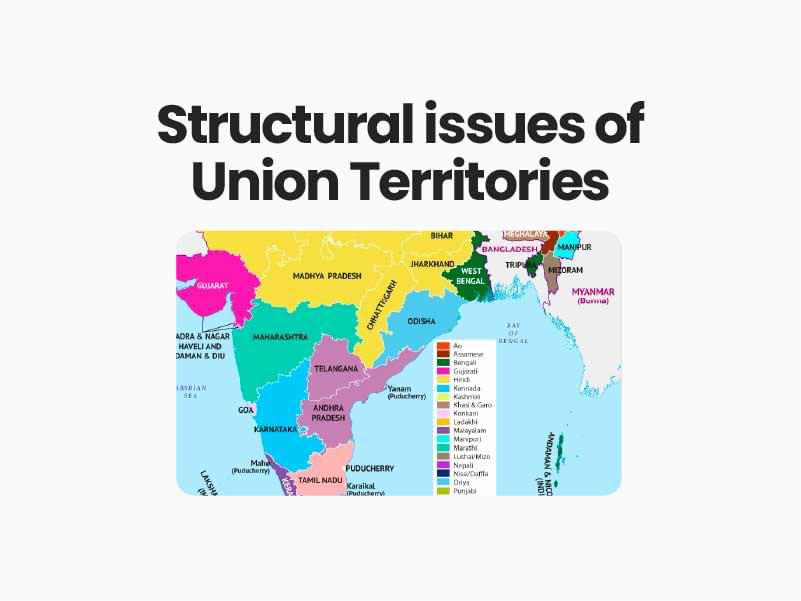Companion@360 → 7 Month programme to sharpen your writing skills → REGISTER NOW

Structural issues of Union Territories
Recently,MLAs from the Puducherry Assembly have turned out to be an ingenious move to topple the government. This was done in 2019 with devastating effect in Karnataka. In both cases, the governments lost majority and went out of office. Resigning from the membership of the House is every member’s right. But according to Article 190 of the Constitution, the resignation should be voluntary or genuine. If the Speaker has information to the contrary, he or she is not obliged to accept the resignation.
- But there is by now a familiar pattern to the resignations of Members of the Legislative Assembly. Such resignations invariably lead to the fall of the government and resignations take place only from the ruling parties in the States which are opposed to the ruling party at the Centre.
- These parties are, in fact, in a precarious condition because in most cases, the resignations are quite unanticipated and reduce the party’s majority in the House abruptly.
- Even the most seasoned Chief Ministers who have weathered many storms look flummoxed in the face of this blow. Resignations are done with such precision that the exact number of MLAs required to reduce the majority resign, not more.
- This mode of toppling a government has an odd attractiveness about it because of its sheer novelty.
- The beauty of this scheme is that no MLA has to defect and face disqualification and get a bad name. It is a wonderful way to end defection and save the honour of the legislators. The Puducherry development has tremendous political significance.
Structural fragility of Union Territories:
Composition of the legislature:
- Article 239 does not meet the democratic aspirations of the people. Therefore, the creation of a legislature and a Council of Ministers is logical and in consonance with the policy of the state to promote democracy.
- But a closer look at the relevant provisions in the Constitution reveals that this professed aim has often been sought to be defeated by the Union.
- Article 239A was originally brought in, in 1962, to enable Parliament to create legislatures for the UTs.
- A legislature without a Council of Ministers or a Council of Ministers without a legislature is a conceptual absurdity.
- In our constitutional scheme, a legislature is the law-making body and a legislative proposal is initiated by the government, which is responsible to the legislature.
- Neither can the legislature exist without a Council of Ministers nor can the Council of Ministers exist without a legislature. Similarly, a legislature that is partly elected and partly nominated is another absurdity.
- In fact, a simple amendment in the Government of Union Territories Act, 1963 can create a legislature with more than 50% nominated members.
Issue of nomination:
- The Government of Union Territories Act provides for a 33-member House for Puducherry of whom three are to be nominated by the Central government.
- So, when the Union government nominated three members to the Assembly without consulting the government, it was challenged in the court.
- The Supreme Court (K. Lakshminarayanan v. Union of India, 2019) held that the Union government is not required to consult the State government for nominating members to the Assembly and the nominated members have the same right to vote as the elected members.
- There is provision for the nomination of members to the Rajya Sabha (under Article 80). The Article specifies the fields from which they will be nominated.
- The purpose of this nomination is to enable the House to draw on the expertise of those eminent members who are nominated and thus enrich the debate in the House.
- However, in the case of nomination to the Puducherry Assembly, no such qualification is laid down either in Article 239A or the Government of Union Territories Act.
- Due to this, the law invites arbitrariness in dealing with the nomination of members to the UT legislature.
Administrator’s power:
- The UTs were never given a fully democratic set-up with the necessary autonomy. The power vested in the administrator (Lieutenant Governor) conflicts with the powers of the elected government of UTs having a legislature.
- Section 44 of the Government of Union Territories Act and Article 239 AA(4) (proviso) of the Constitution vests the power in the administrator to express his or her disagreement and refer the matter to the President
- The President decides on the advice of the Union government. So, in effect, it is the Union government that finally determines the disputed issue.
- This can be reflected in the Chief Minister of Puducherry asking removal of the Lt. Governor.
- Similarly, in the National Capital Territory of Delhi, one often hears of complaints against the Lt. Governor from the ministers about the non-cooperative federalism being practiced by him.
Way Forward:
- Indian Government can emulate the model of administrative sharing of power between the Union government and the Governments of UTs
- Both the government and UTs need to imbibe the ethos of cooperative federalism.
- For effective autonomy to the governments of union territories, there is a need for amendment in the legal and constitutional provisions.
Conclusion:
- Experience shows that the UTs having legislatures with ultimate control vested in the central administrator are not workable. The redemption for the harried governments of these territories lies in the removal of the legal and constitutional provisions which enable the administrator to breathe down the neck of the elected government.
- So far as the conspiratorial resignation by legislators to bring down their own government is concerned, the political class will have to rack its brains on how to get the better of the predatory instincts of political parties through constitutional or other means.
Read Also Sedition Law
